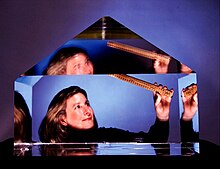Certainly.
Phosphors / Fluorescent dyes (e.g. Fluorescent light bulbs / tunable dye lasers):
If you go to the whimsy section and look for my post 'The secret life of...' and then click the light bulb episode, you'll see the presenter
demonstrating the effect these coatings have on the bulbs spectrum. They are absolutely key to the bulb manufacturers, are patented, and have been the
cause of arguments; e.g. Osram receiving large grants from the German government as 100W incandescent bulbs were forced into phase out.

<img src="http://img.directindustry.com/images_di/photo-g/tunable-dye-laser-84815.jpg" width="800" />
Frequency multiplying crystals (the lower image is of one of the KDP crystals grown for the National Ignition
Facility):


Quantum Wells / Dots:

<iframe sandbox width="640" height="480" src="http://www.youtube.com/embed/MLJJkztIWfg" frameborder="0" allowfullscreen></iframe>
---------------------------------------
The problem is not it being physically impossible, it's the practicality.
The dyes and quantum dots can fade when exposed for prolonged periods.
The crystals can be hydroscopic and will dissolve if exposed to the elements. A number of the materials used can not be wet machined, honed or lapped.
Instead, they are cut using very high precision lathes. The lathes use a single diamond point and can achieve surface finishes in the nanometer (near
atomic) range, with only air blowing over the tool. Such technology is not standard by any means, Moore Nanotech make a few tens of these lathes per
year.
<iframe sandbox width="640" height="360" src="http://www.youtube.com/embed/vAvfrrlMZg4" frameborder="0" allowfullscreen></iframe>
Many of the people looking into viable solar farms do not use traditional solar panels, but Stirling engines. The Stirling engine is the oldest and
simplest form of engine. They can be incredibly reliable and efficient. Rather than growing expensive wafers and special coatings in silicon plants
(an inherently expensive source of material), they use a black body absorber and the heat to drive the engine (which can be made on traditional
machinery).

The design can be very simple; a big sheet of metal bent into a curve with a pipe at the focal point.

Brian Cox gave some good examples in his program on nuclear fusion; How to build a star. People in the UK use around 10kWh of electricity per day.
Assuming we wished to provide 5kWh to everyone in the world over the next few decades, that would mean building two or three fission plants per week
(or was that per day?). And the numbers of panels / turbines is staggering. Not accounting for population growth.
New Scientist was all about fission this month. Of the 170 odd fission plants officially shutdown, only 17 have been fully dismantled since the start
of the nuclear era. As a result of the Fukushima accident, Germany won't be building anymore and will be shutting it's down. Japan may follow suit.
That alone will produce around another 320 million tons of CO2 by 2020 (2025?), which happens to be the same amount that was intended to be saved by
European carbon cuts; nulling them out.
They would all help, along with better insulation in homes, but fusion is the only real solution to the problem. Particularly if we intend to move
forward. It's important we don't waste money that could have been spent on fusion on things that won't do a whole lot.
The UK has the most successful nuclear fusion for power program, and we spent more on ring tones last year than we did the program. Korea is a late
entry, with the final experimental prototype to come online and polish up the design.
K-Star light up in 2008 and is managing 20 seconds of burn time at present, upgrading to 300 soon.
All the work will be rolled out as the prototype power plant ITER (International Thermonuclear Experimental Reactor). Construction has already started
in the South of France.
Edit: I thought you might also be amused to know that such light manipulating technology is all around you. Many of the 'whiter than white' detergents
for shirts contain UV dyes that cause them to literally glow blue during the day. The blue helps 'whiten' the red, orange and yellow in the light they
reflect. You can see the effect very clearly in night clubs that have a black light. The same is also applied to bright white paper, which glows blue
when hit by a UV laser.
Many, many, many molecules can shift frequencies of light and can be seen glowing on TLC plates under UV lights or in the detectors of (U)HPLC.
This girls outfit and make up are absorbing deep blue / long UV and re-emitting it at lower frequencies.

Below is an image of a Claviceps paspali (ergot) culture. The final photograph showing the culture glowing green under UV due to the presence of the
lysergides.

[Edited on 20-3-2012 by peach]
<!-- bfesser_edit_tag -->[<a href="u2u.php?action=send&username=bfesser">bfesser</a>: reduced
image size(s)]
[Edited on 7/25/13 by bfesser]


 )
)













